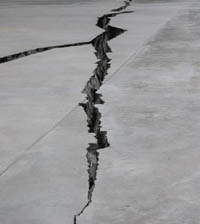 Why does concrete crack?
Why does concrete crack?
Unlocking the mysteries of a critical building resource
 Concrete has been the main stay of building construction for generations. Today, traditional reinforced concrete is an integral and important component of building structures. It usually takes the form of footings in ground, slabs on ground, columns and suspended slabs.
Concrete has been the main stay of building construction for generations. Today, traditional reinforced concrete is an integral and important component of building structures. It usually takes the form of footings in ground, slabs on ground, columns and suspended slabs.
Concrete however, is not the perfect substance. As such it can suffer from defects. These defects can have a huge impact on the appearance, capital expenditure, maintenance costs, safety and effective life of the total structure.
What then are the typical forms of concrete defects? Some of the more common defects can be categorised as follows:-
-
Structural design inadequacies – distortion, bending cracks, deflection, shear cracks, impact damage temperature change cracks, abrasion, torsion cracks and erosion.
-
Environmental causes – weathering/staining, biological growth, bacteriological attack, efflorescence (lime leaching), freeze-thaw damage and fire damage
-
Aggregate properties – aggregate swelling/shrinkage/softening, alkali-silica reaction and sulphide staining/spalling.
-
Chemical attack – sulphates, chlorides, acids and salt weathering.
-
Reinforcement corrosion – cracking, spalling and de-lamination
-
Concrete Cancer – cracking of the concrete caused by the corrosion of steel reinforcement in concrete structures
 The shattering truth about glass
The shattering truth about glass
 Since the 1960s, there have been numerous, high profile incidents of ‘spontaneous” failure of toughened glass in building facades. In some cases, glass has been known to simply ‘pop’ out of high-rise building windows and fall onto the streets below Why does this happen? The cause lies within the makeup of the glass itself.
Since the 1960s, there have been numerous, high profile incidents of ‘spontaneous” failure of toughened glass in building facades. In some cases, glass has been known to simply ‘pop’ out of high-rise building windows and fall onto the streets below Why does this happen? The cause lies within the makeup of the glass itself.
Nickel sulphide is a rare and unintended inclusion in the production of glass panels. However, the presence of nickel sulphide can be a problematic one. This is due to what is technically called, ‘delayed transformation’.
For those interested in technical detail, these follow:
Nickel sulphide crystals can take one of two forms. At high temperatures, a dense crystal is present. At lower temperatures, a less dense crystal is present. Provided the transition from high to low temperature (ie. cooling) is gradual, the crystal can move between forms without problem.
For example, in ordinary annealed glass, the crystals do not cause problems because the cooling process occurs slowly during manufacture.
